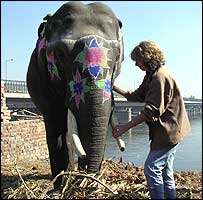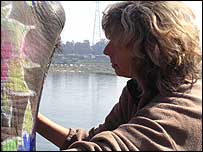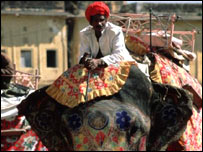Therapy For Stressed Elephants
Written By Adam Mynott, BBC South Asia Correspondent
February 4, 2004

Elke Riesterer says whispering works well with elephants
India’s captive elephants are stressed, unhappy and need therapy, according to the Wildlife Trust of India.
They have called in an expert – a sort of “elephant-whisperer” – from the United States to help them.
Elke Riesterer has done therapy on all sorts of animals, but elephants, she says, are among her favourites.
As she speaks she moves her hands over the rough, hairy flank of Gangara, a huge bull elephant, one of 30 captive elephants living in a colony near the Yamuna River in Delhi.
The elephants are busy most days, working at wedding parties and celebrations, earning their mahouts up to $100 a day.
Elke has been invited by the Wildlife Trust of India from her home in Santa Cruz in California to assess the stress levels of some of the thousands of captive elephants in India.
Their hide may feel rough, but it’s incredibly sensitive to the touch. Elke Riesterer
Gangara seems unconcerned by the attention he is getting. Elke runs her hands over his trunk and head and legs while Gangara munches on a few sugar canes.”I am keeping my hands on him and he’s getting more confident of my presence and he’s now leaning into my hands,” Elke, a German national, told the BBC.
“This animal is very stressed. I can tell that there’s something bothering him. Look at his eyes. He doesn’t look well, they are weeping. I think there’s too much dust and this is not a good environment.”

This animal is very stressed.
Poor health
Dr Anand, a vet with the Wildlife Trust of India, says the condition of the elephants in Delhi is very poor.
“They have a poor diet, poor water and they are kept standing around for far too long, chained by their back legs.”The elephants in the Indian capital live in a filthy environment beneath a bridge, over which runs a six-lane trunk road into the city.
Many have been injured in accidents with cars and motorcycles in the mad bustle of Delhi traffic.
They drink water and bathe in one of the most polluted rivers in India. It is hardly surprising they are not in good condition.
Dr Anand says elephants in captivity elsewhere in India are also suffering. He says some are in better condition than the Delhi animals, but few are as fit or well as they should be.

The elephants are used for ceremonial purposes.
Touch therapy
Elke Riesterer, who has been working on a project at Oakland Zoo in California, says she’s been asked to look at dozens of elephants in six cities across India.
She will treat them with her touch therapy and give her diagnosis of their health. The Tellington Touch Therapy she practices was developed by a British woman, Linda Tellington Jones, and it’s used widely in the equine world to calm and restore stressed horses.
Elke Riesterer says it works well on elephants as well.
“There’s a misconception that elephants have thick, insensitive skins,” she says.
“Their hide may feel rough, but it’s incredibly sensitive to the touch.”
